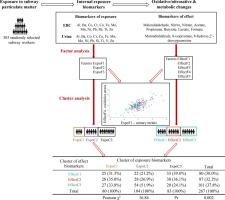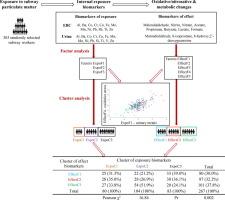呼出冷凝水和尿液中的金属是否与氧化/亚硝化应激和代谢相关的生物标志物有关?调查对象是随机抽取的303名巴黎地铁工作人员
IF 9.7
1区 环境科学与生态学
Q1 ENVIRONMENTAL SCIENCES
引用次数: 0
摘要
地铁微粒会引起氧化应激,其中金属是一个关键因素。只有少数流行病学研究调查了金属混合物在地铁工人的这种影响中的作用。目的本横断面研究探讨了地铁工人呼出冷凝水(EBC)和尿液中金属浓度与氧化/亚硝化应激和代谢生物标志物之间的关系。研究对象是随机选择的303名巴黎地铁工作人员,他们暴露在不同程度的地铁颗粒物中。采用ICP-MS法测定血清和尿液中的金属含量,采用液相色谱-质谱法分析生物标志物。采用因子分析作为降维策略和聚类分析来解释金属混合物和多种多媒体效应生物标志物,并对潜在混杂因素进行多变量线性回归分析。结果尽管工人和普通人群的金属水平相似,但尿金属与氧化应激生物标志物之间存在显著的正相关。EBC中的金属与EBC中的亚硝化应激和其他代谢物有关。工人职业与EBC小链脂肪酸和尿钡、钛水平相关。吸烟与效应生物标志物相关,但与暴露生物标志物无关。结论EBC和尿液中金属水平升高与支气管肺代谢产物改变和全身氧化应激增加有关。虽然钡和钛可能来自刹车磨损,但在EBC和尿液中发现的其他金属与地铁颗粒没有明显关系,可能来自非职业来源。吸烟与工人氧化应激状态的关系强于职业。本文章由计算机程序翻译,如有差异,请以英文原文为准。


Are metals in exhaled breath condensate and urine associated with oxidative/nitrosative stress and metabolism-related biomarkers? Results from 303 randomly selected Parisian subway workers
Background
Subway particles can cause oxidative stress, with metals being a key factor. Only few epidemiological studies have examined the role of metal mixtures in this effect for subway workers.
Objectives
This cross-sectional study examined the relationship between metal concentrations in exhaled breath condensate (EBC) and urine, and biomarkers of oxidative/nitrosative stress and metabolism in subway workers.
Methods
The study involved 303 randomly selected Parisian metro workers exposed to various levels of subway particles. Metals in EBC and urine were measured using ICP-MS, and biomarkers were analyzed through liquid chromatography-mass spectrometry. Factor analysis as dimension reduction strategy and cluster analysis to account for metal mixtures and multiple multi-media effect biomarkers was used along with multivariable linear regression analysis on factor variables adjusted for potential confounders.
Results
Significant positive associations were observed between urinary metals and oxidative stress biomarkers, despite similar metal levels in workers and the general population. Metals in EBC were linked to nitrosative stress and other metabolites in EBC. Worker occupation correlated with small chain fatty acids in EBC and urinary levels of barium and titanium. Smoking was associated with effect biomarkers but not with exposure biomarkers.
Conclusions
Elevated metal levels in EBC and urine are associated with altered bronchopulmonary metabolites and increased systemic oxidative stress. While Ba and Ti may originate from brake wear, other metals identified in EBC and urine are not clearly related with subway particles and may be from non-occupational sources. Smoking showed a stronger relationship with the workers’ oxidative stress status than occupation.
求助全文
通过发布文献求助,成功后即可免费获取论文全文。
去求助
来源期刊

Environment International
环境科学-环境科学
CiteScore
21.90
自引率
3.40%
发文量
734
审稿时长
2.8 months
期刊介绍:
Environmental Health publishes manuscripts focusing on critical aspects of environmental and occupational medicine, including studies in toxicology and epidemiology, to illuminate the human health implications of exposure to environmental hazards. The journal adopts an open-access model and practices open peer review.
It caters to scientists and practitioners across all environmental science domains, directly or indirectly impacting human health and well-being. With a commitment to enhancing the prevention of environmentally-related health risks, Environmental Health serves as a public health journal for the community and scientists engaged in matters of public health significance concerning the environment.
 求助内容:
求助内容: 应助结果提醒方式:
应助结果提醒方式:


